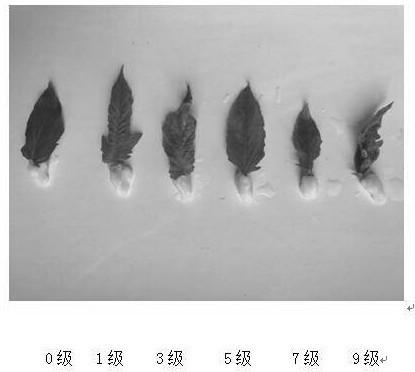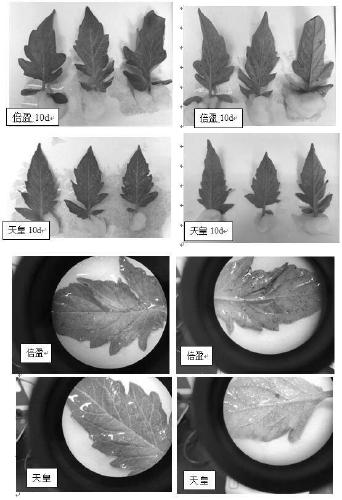Method for identifying resistance of tomato leaf mold by using in-vitro leaves
A technology of tomato leaf mold and detached leaves, applied in the field of tomato leaf mold, can solve the problems of difficult preservation of rare resources, high cost, long detection cycle, etc., and achieve low detection cost, good for preservation, and small space occupation Effect
- Summary
- Abstract
- Description
- Claims
- Application Information
AI Technical Summary
Problems solved by technology
Method used
Image
Examples
Embodiment 1
[0057] (1) Planting of tomato seedlings: The tomato variety "Nippon Mikado" and "Beiying" were raised in the greenhouse. Before the seedlings were raised, the utensils and 50-hole seedling trays were washed and sterilized with 5% sodium hypochlorite. The nutrient soil for seedlings was vermiculite , perlite, peat (1:1:3) mixed compound soil, sow double seeds after high temperature sterilization, keep 1 seedling in each hole, 2 trays for each material, 50 plants in each tray. Take it when the seedlings are about 30 days old (5-6 true leaves).
[0058] (2) Treatment of tomato leaves: the leaves to be tested are the 2nd to 4th leaves (about 5-7cm in size), with the same maturity, rinsed with detergent water for 2 minutes, rinsed with tap water, and then rinsed with sterile water Rinse twice, dry naturally, and set aside.
[0059] (3) Leaf mold culture: Take leaf mold leaves from typical diseased plants in the field, and separate and purify them on PDA medium. And place it in a ...
PUM
 Login to View More
Login to View More Abstract
Description
Claims
Application Information
 Login to View More
Login to View More - R&D
- Intellectual Property
- Life Sciences
- Materials
- Tech Scout
- Unparalleled Data Quality
- Higher Quality Content
- 60% Fewer Hallucinations
Browse by: Latest US Patents, China's latest patents, Technical Efficacy Thesaurus, Application Domain, Technology Topic, Popular Technical Reports.
© 2025 PatSnap. All rights reserved.Legal|Privacy policy|Modern Slavery Act Transparency Statement|Sitemap|About US| Contact US: help@patsnap.com



